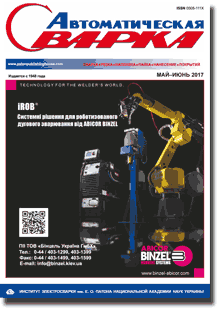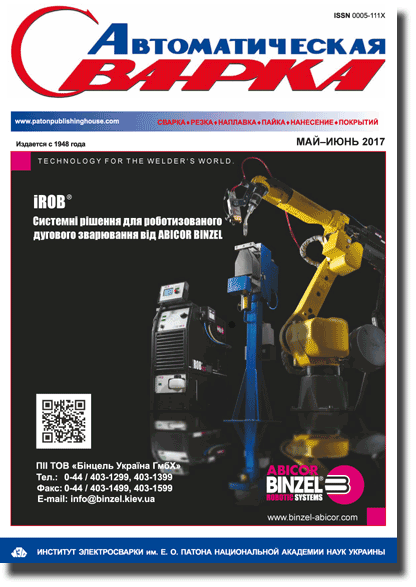| 2017 №06 (14) |
DOI of Article 10.15407/as2017.06.15 |
2017 №06 (16) |

Avtomaticheskaya Svarka (Automatic Welding), #6, 2017, pp. 91-98
Development of automated equipment for manufacturing 3D metal products based on additive technologies
V.N. Korzhik1, A.N. Vojtenko1,2, S.I. Peleshenko3,4, V.I. Tkachuk1,2, V.Yu. Khaskin1 and A.A. Grinyuk1,5
1E.O. Paton Electric Welding Institute, NASU 11 Kazimir Malevich Str., 03680, Kiev, Ukraine. E-mail: office@paton.kiev.ua
2RPC «PLAZER» 1 Build., 17A General Naumov Str., Kiev, Ukraine
3Institute of Mechanical Engineering and Car-Making of South-China University of Technology 381 Build., 381 Wushan Str., Guangdong, Guangzhou, 510641, China
4Weihan Science and Technology Company A4 Bld., Xi’an Av. 1001, Shenzhen, Guangzhou, 518071 China
5NTUU «Igor Sikorsky KPI» 37 Pobedi Prosp., Kiev, Ukraine
Abstract
Additive technologies have huge potential for lowering the energy and material costs for development of the most diverse kinds of products. An increase of the proportion of welding technologies in additive manufacturing of bulk metal products is currently observed. This is associated both with high efficiency of arc welding (surfacing) and with its low cost. The paper describes an automated complex for 3D printing of metal products. It is shown that the developed automated complex allows manufacturing bulk metal products by the methods of additive consumable electrode arc surfacing (at up to 80 A currents), plasma surfacing with wires (at up to 120 A currents) and microplasma surfacing with powder materials (at up to 50 A currents). 10 Ref., 7 Figures.
Keywords: additive building-up, microplasma surfacing, wires, powders, equipment complex, technological research, metallography
Received: 12.05.17
Published: 06.07.17
References
- Kruth, J.P., Leu, M.C., Nakagawa, T. (1998) Progress in additive manufacturing and rapid prototyping. CIRP Annals — Manufact. Technology, 47(2), 525–540. https://doi.org/10.1016/S0007-8506(07)63240-5
- Slyusar, V.I. (2003) Fabber-technologies. New mean of three-dimensional simulation. Elektronika: Nauka, Tekhnologiya, Biznes, 5, 54–60.
- Korzhik, V.N., Khaskin, V.Yu., Grinyuk, A.A. et al. (2016) 3D-printing of metallic volumetric parts of complex shape based on welding plasma-arc technologies (Review). The Paton Welding J., 5/6, 117–123. https://doi.org/10.15407/tpwj2016.06.20
- Bruce, M.R., Riley, S.F., Cola, M.J. et al. (2012) Measurement and simulation of titanium alloy deposit temperature in electron beam additive manufacturing. In: of 9th Int. Conf. on Trends in Welding Research 2012 (June 4–8 2012, Chicago, USA), 963–969.
- Kruth, J.P. (2004) Selective laser melting of iron-based powder. Mater. Process. Technol., 149, 616–622. https://doi.org/10.1016/j.jmatprotec.2003.11.051
- Alhuzaim, A.F. (2014) Investigation in the use of plasma arc welding and alternative feedstock delivery method in additive manufacture: Syn. of Thesis for Master of Sci. Degree. USA: University of Montana.
- Baufeld, B., Van der Biest O., Gault, R.S. (2010) Additive manufacturing of Ti–6Al–4V components by shaped metal deposition: Microstructure and mechanical properties. Materials & Design, 31, 106–111. https://doi.org/10.1016/j.matdes.2009.11.032
- Clark, D., Bache, M.R., Whittaker, M.T. (2008) Shaped metal deposition of a nickel alloy for aeroengine. Materials Proc. Technology, 203, 439–448.
- (2009) Main elements of SolidWorks (SolidWorks 2010). Dassault Systems SolidWorks Corp.
The cost of subscription/purchase order journals or individual articles
| Journal/Currency | Annual Set | 1 issue printed |
1 issue |
one article |
| TPWJ/USD | 384 $ | 32 $ | 26 $ | 13 $ |
| TPWJ/EUR | 348 € | 29 € | 24 € | 12 € |
| TPWJ/UAH | 7200 UAH | 600 UAH | 600 UAH | 280 UAH |
| AS/UAH | 1800 UAH | 300 UAH | 300 UAH | 150 UAH |
| AS/USD | 192 $ | 32 $ | 26 $ | 13 $ |
| AS/EUR | 180 € | 30 € | 25 € | 12 € |
| SEM/UAH | 1200 UAH | 300 UAH | 300 UAH | 150 UAH |
| SEM/USD | 128 $ | 32 $ | 26 $ | 13 $ |
| SEM/EUR | 120 € | 30 € | 25 € | 12 € |
| TDNK/UAH | 1200 UAH | 300 UAH | 300 UAH | 150 UAH |
| TDNK/USD | 128 $ | 32 $ | 26 $ | 13 $ |
| TDNK/EUR | 120 € | 30 € | 25 € | 15 € |
AS = «Automatic Welding» - 6 issues per year;
TPWJ = «PATON WELDING JOURNAL» - 12 issues per year;
SEM = «Electrometallurgy Today» - 4 issues per year;
TDNK = «Technical Diagnostics and Non-Destructive Testing» - 4 issues per year.





